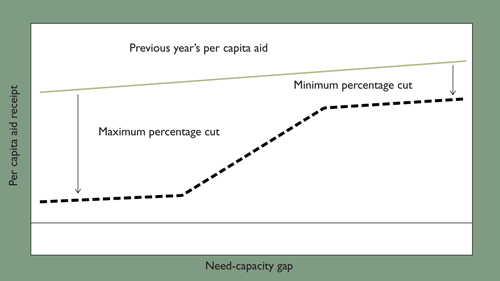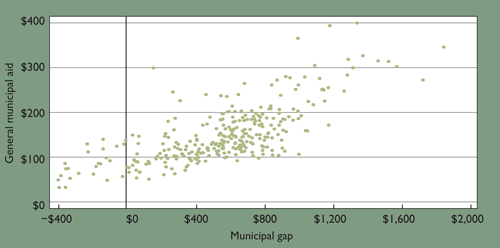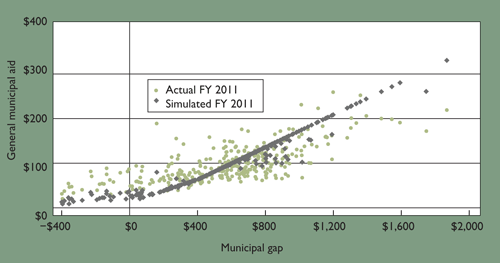Making Cuts in State Aid More Equitable 
Revenue shortfalls have forced states to cut aid to municipalities. The authors suggest a way to make cuts without dismantling years of efforts to help the neediest communities.
State aid plays an important role in local government finances in New England. In fiscal year (FY) 2008, for example, revenue transfers from state government made up on average 33 percent of local governments' general revenues, ranging from 29 percent in New Hampshire to 67 percent in Vermont.[1] Local governments rely on state aid to provide essential services, such as education, police and fire protection, and road maintenance.
However, in the ongoing fiscal crisis, state governments have deeply cut local aid.[2] In FY 2010 alone, Massachusetts and New Hampshire reduced non school aid by 21 percent; Rhode Island and Connecticut cut total aid by about 12 percent and 2 percent, respectively.[3]
When states cut aid across the board, as often happens, each community receives the same percentage reduction. But that approach fails to take into account differences in underlying fiscal health or existing aid distribution across communities.
Indeed, because existing aid is usually aimed at reducing fiscal imbalances, resource-poor communities tend to receive a larger amount, and they depend more on state aid than do resource-rich communities. For example, in FY 2008, municipalities in the bottom 20 percent of per capita taxable property values among Massachusetts communities received average per capita state aid of $1,321, nearly half of their total general revenue. In comparison, communities in the top 20 percent received only $339, or 10 percent of their total general revenue. Thus across-the board percentage cuts may result in larger per capita aid cuts for resource-poor communities.
Local officials have raised concerns that across-the-board aid cuts widen the gap between resource-rich and resource-poor communities, undoing years of fiscal equalization. In response, we propose a twopronged approach that is more equitable.[4] First, holding per capita existing aid equal, the approach cuts less aid from communities that, through no fault of their own, have worse underlying fiscal health. Second, among communities with similar underlying fiscal health, it cuts less from communities that received less aid the previous year.
A More Equitable Approach
It is necessary first to identify a way of measuring underlying local fiscal health. In our previous research, we developed what we call the need-capacity gap, a measure that shows the difference between the underlying costs of providing local public services to a community and the community's capacity to raise revenue from local sources to fund those services. A larger need-capacity gap indicates worse fiscal health.
We base each community's underlying costs and capacity only on local social and economic characteristics that are outside the direct control of local government. These are not actual levels of spending and revenues. Focusing on factors beyond the control of local governments keeps states from rewarding wasteful local spending or punishing efficient operations.
Using a gap-based aid-reduction approach, a state could distribute cuts more equitably. (See "Aid Cuts under the Gap-Based Approach.") For simplicity, we assume that existing aid was distributed in proportion to need-capacity gaps, although that is often not the case.
Under our approach, communities with small need-capacity gaps would receive the maximum percentage cut from their previous year's aid. Policymakers would cap the maximum aid cut to ensure that no community would lose all its aid. Communities with the largest need-capacity gaps would receive a minimum aid cut. Having a nonzero minimum aid cut ensures that all cities and towns share some burden of a cut, regardless of local fiscal health.
Note that municipalities not receiving the minimum or maximum cut would receive aid cuts inversely proportional to their gap. This means that communities with worse underlying fiscal health (for example, because of lower taxable property values) would lose less than those with better underlying fiscal health.
Massachusetts
In principle, this approach can be applied to all states providing local aid. To illustrate, we explore Massachusetts general municipal aid and simulate the effect of the proposed gap-based approach.
Massachusetts allocates general municipal aid to its 351 cities and towns with a declared goal of equalizing their ability to provide municipal services. Total general municipal aid reached a peak of $1.3 billion in FY 2008. After the recession, the state cut general municipal aid across the board by about 10 percent (FY 2009), 21 percent (FY2010), and 4 percent (FY 2011). That presented an opportunity to simulate what the aid distribution would look like if the state had used a gap-based approach to cuts.
Aid Cuts Under the Gap-Based Approach

Source: Authors' illustration.
Municipal Aid vs. Municipal Gaps in Massachusetts (FY 2008, per capita)

Note: To show the general pattern more clearly, 40 communities with a per capita gap below -$400 have been omitted.
Source: Authors' calculations.
Simulated Aid Distribution vs. Actual (FY 2011, per capita)

Note: To show the general pattern more clearly, 40 communities with a per capita gap below -$400 have been omitted.
Source: Authors' calculations.
To measure the need-capacity gap for municipal services (the municipal gap, for short), we focused on social and economic characteristics outside the direct control of local officials in any given year. Our previous research pointed to four significant cost factors in Massachusetts: the poverty rate, the unemployment rate, population density, and the number of per capita jobs located in the municipality.[5]
The research found that the capacity to raise revenue from local property taxes is determined both by taxable property values and the personal income of local residents. We also included revenue capacity from various local excises, such as the motor vehicle excise and the local hotel and motel excise. However, we needed to subtract state-required local contributions to public schools and other required assessments and charges from municipal capacity, since those funds are not available for municipal services.[6]
Despite the state's goal of fiscal equalization, municipal-aid distribution was not directly proportional to municipal gaps in FY 2008. (See "Municipal Aid vs. Municipal Gaps in Massachusetts.") Communities with similar gaps received very different municipal aid amounts, and communities with similar aid receipts had different municipal gaps. A more equitable aid-reduction approach should take into account both differences in municipal gaps and the existing aid distribution across communities.
We ran a data simulation to explore what the aid distribution could have looked like if the state had used the gap-based approach. We distributed the actual statewide cuts in municipal aid fromok
FY 2009 to FY 2011 using a gap-based formula. In a policy scenario, we set the maximum percentage aid cut for any community to 2.5 times the statewide aid cut, and the minimum percentage cut to one-tenth of the statewide percent cut in each year.
Under the actual aid cuts, each community across the state lost roughly 31 percent of its aid. If Massachusetts had used the gap-based approach, higher-gap communities would have experienced a smaller percent aid cut than lower-gap communities. Communities in the top 20 percent of the gap distribution-those with the worst underlying fiscal health-would have lost 24 percent of their aid, on average. Communities in the bottom 20 percent would have experienced a 66 percent reduction in aid over the three-year period.
More than half of all communities in the state would have received smaller cuts under the gap-based approach than with the across-the-board cuts. Together, these communities have about 52 percent of the state's population and often have large municipal gaps.
Aid payments would obviously be more closely related to municipal gaps if the state had implemented the gap-based approach. (See "Simulated Aid Distribution vs. Actual.") Indeed, a comparison of the actual FY 2011 municipal aid distribution and the simulated FY 2011 municipal aid distribution reveals that FY 2011 aid bore little relation to municipal gaps. A gapbased approach would have created a stronger relationship between state aid and community need.
Cutting aid across the board appears equitable on the surface, but it ignores the relative fiscal health of local communities. It tends to put more burden on communities that have fewer resources and are already fiscally stressed. The gap-based aid-cut approach would help state governments improve fiscal equalization, even in difficult times.
Bo Zhao is a senior economist in the New England Public Policy Center of the Federal Reserve Bank of Boston, where David Coyne is a senior research assistant.
Endnotes
[1] See the Census Bureau's 2008 Annual Survey of State and Local Government Finance, http://www.census.gov/govs/state/historical_data_2008.html.
[2] For the purposes of this article, we do not address whether there should be aid cuts.
[3] Aid reduction numbers are calculated from the National Association of State Budget Officers' Fiscal Survey of States, http://nasbo.org/Publications/FiscalSurvey/FiscalSurveyArchives/tabid/106/Default.aspx; New Hampshire Municipal Association's State Aid to Municipalities: History and Trends, http://www.nhlgc.org/attachments/nhma/StateAid_booklet.pdf; and Massachusetts Department of Revenue Cherry Sheets, http://www.mass.gov/dor/local-officials/municipal-data-and-financial-management/cherry-sheets/.
[4] Bo Zhao and David Coyne, "Designing Formulas for Distributing Reductions in State Aid" (New England Public Policy Center working paper 11-2, Federal Reserve Bank of Boston, August 2011).
[5] Katharine Bradbury and Bo Zhao, "Measuring Non-School Fiscal Disparities among Municipalities," National Tax Journal 62, no. 1 (2009): 25-56.
[6] A more detailed explanation of municipal gap calculations for Massachusetts cities and towns can be found in Bo Zhao, Marques Benson, Lynn Browne, Prabal Chakrabarti, DeAnna Green, Yolanda Kodrzycki, Ana Patricia Muñoz, and Richard Walker, "Does Springfield Receive its Fair Share of Municipal Aid? Implications for Aid Formula Reform in Massachusetts" (New England Public Policy Center working paper 10-4, Federal Reserve Bank of Boston, July 2010).
Articles may be reprinted if Communities & Banking and the author are credited and the following disclaimer is used: "The views expressed are not necessarily those of the Federal Reserve Bank of Boston or the Federal Reserve System. Information about organizations and upcoming events is strictly informational and not an endorsement."

 About the Authors
About the Authors
Bo Zhao,
Federal Reserve Bank of Boston
Bo Zhao is a principal economist with the New England Public Policy Center in the Federal Reserve Bank of Boston Research Department.
Email: Bo.Zhao@bos.frb.org
David Coyne, Federal Reserve Bank of Boston



